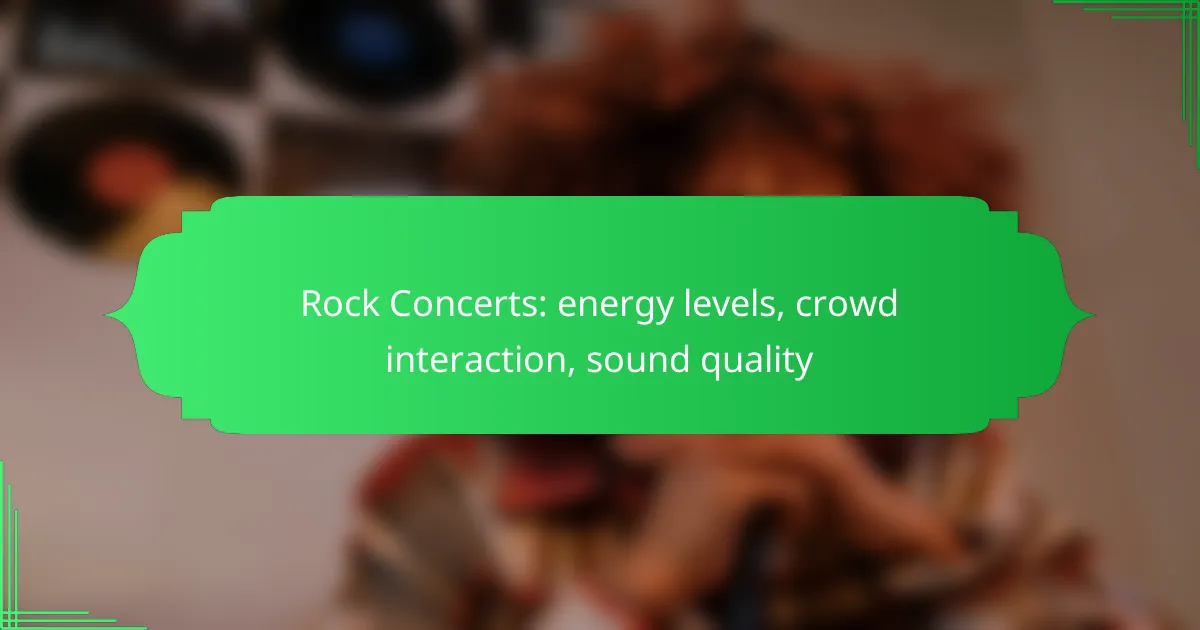Rock concerts are a dynamic fusion of energy levels, crowd interaction, and sound quality, all of which play crucial roles in shaping the overall experience. High energy from both performers and the audience creates an electrifying atmosphere, while meaningful crowd engagement fosters a sense of community. Additionally, sound quality, characterized by clarity and volume, directly impacts how the music resonates with attendees, enhancing their enjoyment and connection to the performance.

How do energy levels impact rock concerts in Toronto?
Energy levels significantly influence the atmosphere and overall experience of rock concerts in Toronto. High energy can create a vibrant, interactive environment, while low energy may lead to a lackluster performance and disengaged audience.
High energy enhances audience engagement
When performers exhibit high energy, it often translates to increased audience engagement. Fans are more likely to participate, sing along, and dance, creating a lively atmosphere that enhances the concert experience. This interaction can lead to memorable moments that resonate long after the show ends.
For instance, bands that move around the stage, interact with fans, and maintain a fast-paced setlist tend to keep the crowd energized. This dynamic can result in a feedback loop where the audience’s excitement further fuels the band’s performance.
Low energy can lead to disengagement
Conversely, low energy during a performance can result in audience disengagement. When bands appear disinterested or deliver a lackluster show, fans may lose interest, leading to a quieter crowd and a less enjoyable experience. This disengagement can manifest as fewer sing-alongs, less dancing, and an overall subdued atmosphere.
In Toronto, where audiences are known for their enthusiasm, a drop in energy can be particularly noticeable. Fans may even leave early if the performance fails to captivate their attention.
Examples of high-energy performances
Several iconic rock concerts in Toronto have showcased high-energy performances that left lasting impressions. For example, the Foo Fighters at the Air Canada Centre delivered a show filled with crowd interaction, powerful guitar riffs, and an electric atmosphere that kept fans on their feet.
Another notable performance was by The Rolling Stones at the Rogers Centre, where Mick Jagger’s dynamic stage presence and the band’s energetic setlist created an unforgettable experience for attendees.
Factors influencing energy levels
Multiple factors can influence the energy levels at rock concerts, including the band’s performance style, setlist, and venue atmosphere. Bands that incorporate engaging visuals, such as light shows and stage effects, often enhance the overall energy of the concert.
Additionally, the venue’s acoustics and layout can impact how energy is perceived. A smaller, more intimate venue may foster a different kind of energy compared to a large arena, where sound and crowd dynamics can vary significantly.
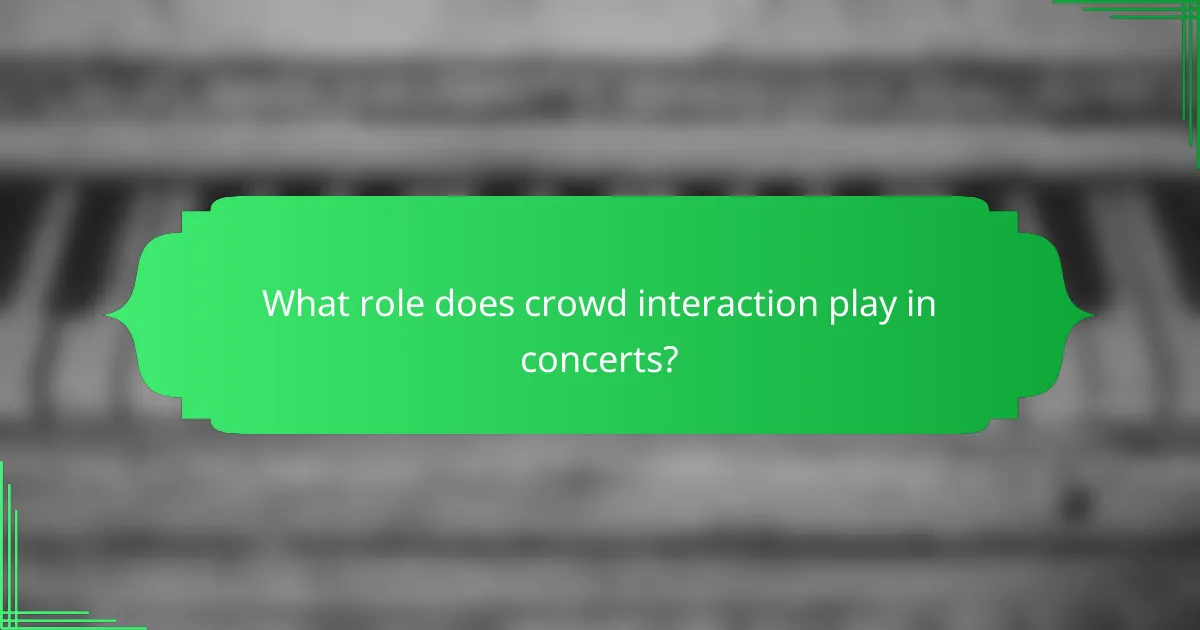
What role does crowd interaction play in concerts?
Crowd interaction significantly enhances the concert experience by fostering a sense of community and excitement among attendees. Engaging with the audience not only energizes the performers but also elevates the overall atmosphere, making the event memorable for everyone involved.
Increased excitement through participation
When concertgoers actively participate, such as singing along or clapping, it creates a shared energy that amplifies the excitement. This collective involvement can lead to a more vibrant and dynamic performance, as artists often feed off the crowd’s enthusiasm. Encouraging participation can transform a standard show into an electrifying experience.
To maximize this interaction, artists might invite fans to sing specific parts of a song or engage in call-and-response segments. These moments not only boost excitement but also strengthen the connection between the performer and the audience.
Impact of crowd surfing and mosh pits
Crowd surfing and mosh pits are extreme forms of crowd interaction that can significantly impact the concert’s energy levels. While crowd surfing allows fans to physically connect with the performance, mosh pits create a chaotic yet exhilarating environment where attendees can express their enthusiasm through movement.
However, these activities come with risks, including potential injuries. Venues often have safety measures in place, and attendees should be aware of their surroundings to ensure a fun yet safe experience. Understanding the culture surrounding these interactions can help fans navigate them effectively.
Examples of interactive moments
Interactive moments can vary widely depending on the artist and the genre. For instance, rock bands might encourage fans to jump during a particularly intense chorus, while pop artists may lead dance routines. These moments create lasting memories and enhance the connection between the audience and the performers.
Some notable examples include artists who invite fans on stage for a song or those who dedicate songs to specific sections of the crowd. These gestures not only engage the audience but also personalize the concert experience, making it unique for each attendee.
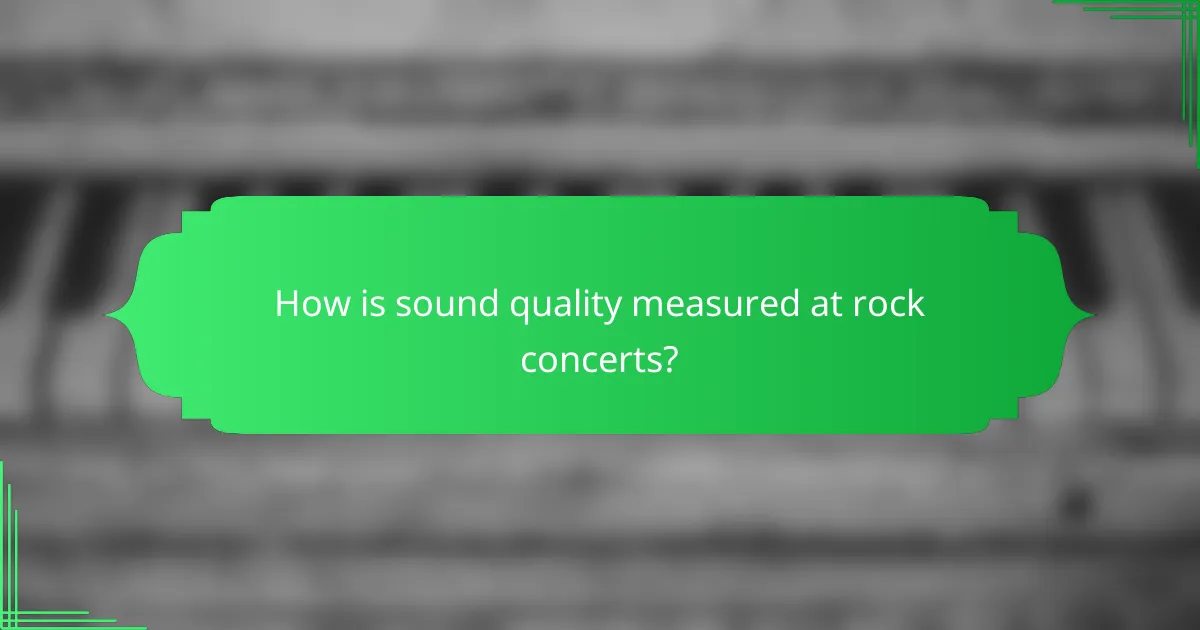
How is sound quality measured at rock concerts?
Sound quality at rock concerts is primarily measured through decibel levels, clarity, and overall audience experience. These factors determine how well the music is delivered and perceived by the crowd, influencing their enjoyment and interaction with the performance.
Decibel levels and clarity
Decibel levels indicate the loudness of sound, with levels typically ranging from 90 to 120 dB at rock concerts. While high decibel levels can energize the crowd, clarity is crucial to ensure that vocals and instruments are distinguishable. Balancing volume and clarity is essential to prevent distortion, which can detract from the overall experience.
Sound engineers often use sound level meters to monitor decibel levels throughout the concert, making real-time adjustments to maintain clarity without sacrificing energy. This ensures that the audience can fully appreciate the nuances of the performance.
Importance of sound engineering
Sound engineering plays a vital role in achieving high-quality sound at rock concerts. Skilled sound engineers use various techniques, including equalization and mixing, to enhance audio quality and adapt to different venues. Their expertise ensures that sound is evenly distributed across the audience area, preventing dead spots where sound may be less clear.
Investing in quality sound equipment and employing experienced engineers can significantly improve the overall sound experience. This not only enhances audience satisfaction but also fosters a stronger connection between the performers and the crowd.
Comparison of venues in Canada
In Canada, sound quality can vary significantly between venues due to size, acoustics, and equipment. Larger arenas like the Scotiabank Arena in Toronto can handle higher decibel levels but may face challenges with clarity in the back rows. In contrast, smaller venues like the Horseshoe Tavern in Toronto often provide more intimate settings where sound quality can be more easily controlled.
When planning a concert, it’s essential to consider the venue’s acoustic properties and sound system capabilities. Venues with good acoustics and modern sound systems generally offer a better auditory experience, making them preferable choices for rock concerts.

What are the prerequisites for a successful concert experience?
A successful concert experience hinges on several key factors, including the right venue, artist popularity, and a well-curated setlist. These elements significantly influence energy levels, crowd interaction, and overall sound quality during the performance.
Venue selection criteria
The venue plays a crucial role in shaping the concert atmosphere. Consider factors such as capacity, acoustics, and location. A smaller venue may foster more intimate interactions, while larger arenas can amplify energy levels through crowd size.
Accessibility is another important criterion. Ensure the venue is easy to reach via public transport or has ample parking options. Additionally, check for amenities like restrooms and food vendors, as these can enhance the overall experience.
Artist popularity and setlist
The popularity of the artist can significantly impact crowd engagement and energy. Well-known artists often draw larger audiences, creating a more vibrant atmosphere. However, emerging artists can also provide unique experiences with passionate fans.
The setlist is equally vital; a well-structured lineup keeps the audience engaged. Mixing popular hits with new material can maintain excitement. Consider the flow of the concert, ensuring peaks and valleys in energy to keep the crowd invested throughout the performance.
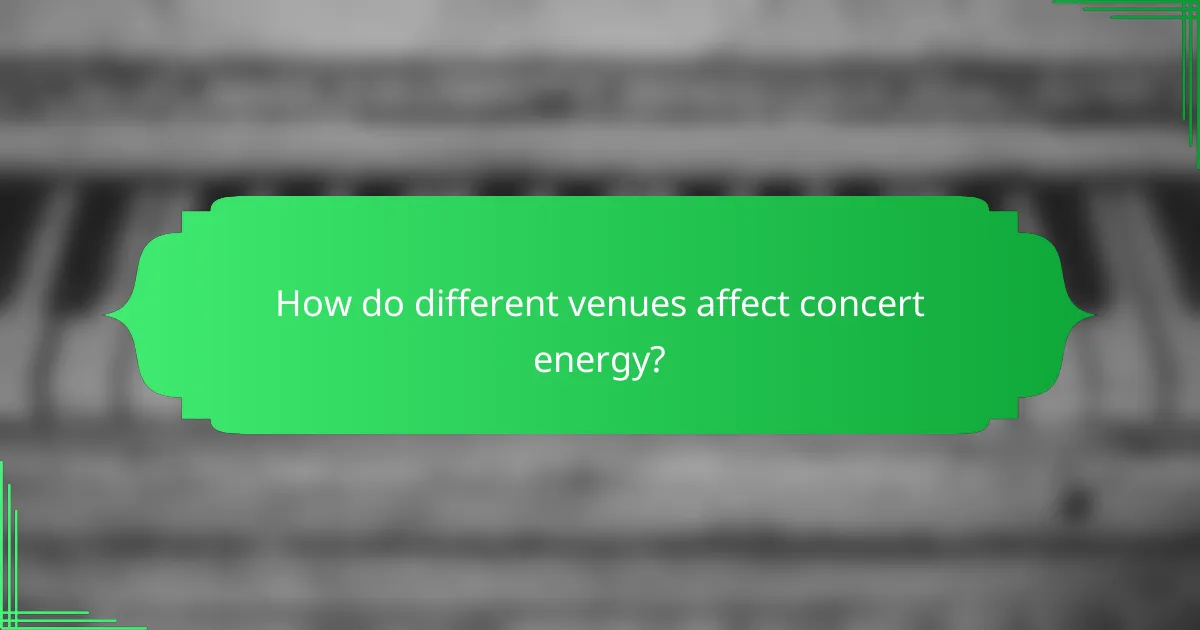
How do different venues affect concert energy?
Different venues significantly influence concert energy by shaping the atmosphere, audience engagement, and overall sound quality. Open-air spaces often create a more vibrant and communal feel, while indoor venues can enhance acoustics and intimacy.
Open-air vs. indoor venues
Open-air venues typically foster a lively, energetic environment due to their spaciousness and natural elements. Concert-goers can enjoy the freedom of movement, which often leads to more enthusiastic crowd interactions.
In contrast, indoor venues provide controlled acoustics that can enhance sound quality, making it easier for audiences to connect with the performance. The enclosed space can create a more intimate atmosphere, allowing for deeper engagement between the artist and the audience.
Capacity and layout considerations
The capacity of a venue plays a crucial role in concert energy. Smaller venues often lead to a more intense experience, as the close proximity of the audience to the performers can amplify excitement. Larger venues, while capable of hosting more fans, may dilute the energy if the crowd feels disconnected from the stage.
Layout also affects how energy flows within the venue. A well-designed space with good sightlines and sound distribution can enhance the overall experience, encouraging crowd participation. Conversely, poor layouts can hinder interaction and reduce the overall energy of the concert.
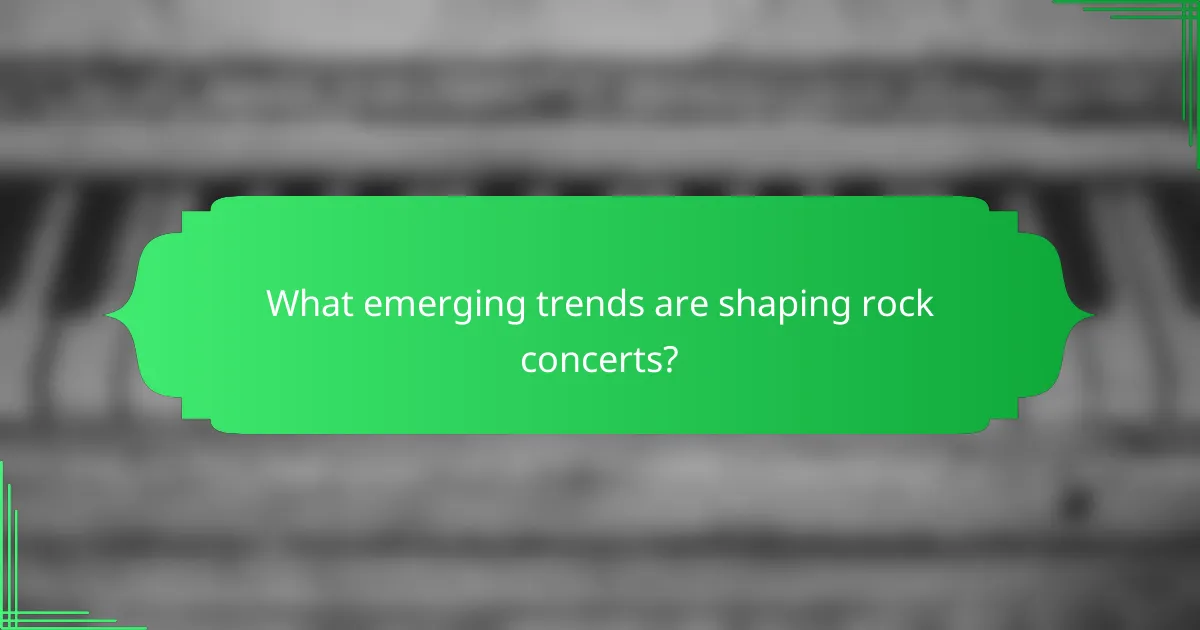
What emerging trends are shaping rock concerts?
Emerging trends in rock concerts focus on enhancing audience engagement, improving sound quality, and integrating technology. These trends are reshaping the concert experience, making it more immersive and interactive for fans.
Energy levels
Energy levels at rock concerts are increasingly influenced by the use of advanced lighting and visual effects. These elements create a dynamic atmosphere that keeps the audience engaged and energized throughout the performance. Bands are also incorporating more interactive segments, such as call-and-response moments, to boost crowd participation.
To maintain high energy, performers often curate setlists that include a mix of their most popular songs and newer material. This approach not only excites longtime fans but also introduces fresh tracks to the audience, keeping the overall energy vibrant.
Crowd interaction
Crowd interaction is becoming a focal point at rock concerts, with artists actively engaging with fans through social media and live polls. This direct communication fosters a sense of community and connection, making attendees feel more involved in the experience. Some bands even invite fans on stage or encourage them to share their concert experiences online.
Additionally, many concerts now feature designated areas for fan interaction, such as meet-and-greet sessions or VIP zones. These opportunities enhance the overall experience and create lasting memories for attendees.
Sound quality
Sound quality at rock concerts is improving due to advancements in audio technology and sound engineering. High-definition sound systems and innovative mixing techniques ensure that every note is crisp and clear, enhancing the listening experience. Venues are also investing in acoustic treatments to optimize sound distribution throughout the space.
To ensure the best sound quality, concert organizers are increasingly using sound checks that involve audience feedback. This practice helps identify any issues and allows for real-time adjustments, ensuring that the concert delivers an exceptional auditory experience.
